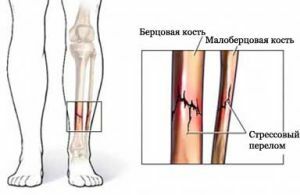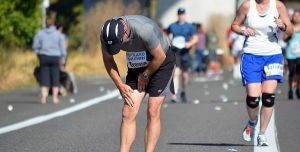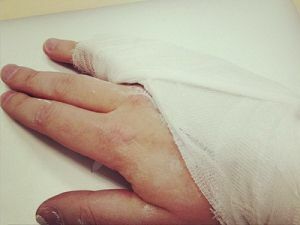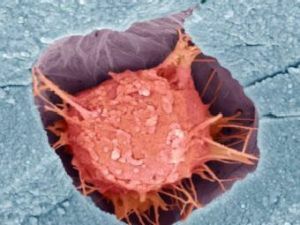 Athletes and people actively involved in sports often face various injuries, among which the most common are stress or fatigue fractures.
Athletes and people actively involved in sports often face various injuries, among which the most common are stress or fatigue fractures.
There are many factors that can cause this problem, as well as treatment methods.
Contents of the article
- Processes that lead to injury
- First manifestations
- Approach to diagnosis
- How to restore health?
- Possible complications of
- How to avoid injury?
Processes that lead to injury
It's no secret that muscle tissue can regenerate.
If a microtrauma is received, it is automatically restored after some time, however, this is true under the usual load conditions.
However, in the case of athletes or people leading an active lifestyle, especially if they are beginners, everything looks a little different. Due to constant workloads and training, a person receives a microtrauma.
They can easily be overlooked, but as accumulation, the body receives an overload, not having time to regenerate the damaged site, and as a result there is a stress fracture.
The main factors of its appearance can serve:
- shoes;
- too high loads;

- coating in the gym;
- unfamiliar surfaces, for example, change of a ground;
- mild muscle tone;
- problems with weight;
- bone disease, eg osteoporosis or bone strength deterioration;Hormonal and clinical changes.
In other words, a stress fracture is a consequence of excessive load on the legs, resulting in the muscles overstraining and ceasing to absorb the impact on the bones.
The result is a crack, which is called a stress fracture.
Such injuries are given to athletes who do not have any rest intervals between competitions and training.
The first manifestations of
The main symptom is acute pain, which subsides at rest, and then builds up in case of physical activity. In the place of damage, a tumor develops and the temperature rises.
In half of cases, fatigue fracture occurs around the bones of the foot and lower leg, in the second half the neck and head of the femur, the sacrum, pubic, sciatic bones, and the lower and upper extremities of the pelvis suffer.
Approach to diagnosis
 In fact, most stress fractures can heal on their own, if surgical intervention is required, then in very rare cases.
In fact, most stress fractures can heal on their own, if surgical intervention is required, then in very rare cases.
The injury is diagnosed in two ways: with palpation and on an X-ray.
In the first case, it is not possible to accurately diagnose the presence and location of the fracture, especially if it concerns the hip area.
Tests by palpation are applied after the level of physical activity is specified, and the diagnosis is made with a positive pain result.
More accurate information is obtained using X-rays. However, this is not always possible, some fractures appear in the picture only after a few weeks after getting injured. Therefore, an additional tomography is used.
How to restore health?
As already mentioned, such fractures, as a rule, heal independently.
However, this does not mean completely giving up physical activity, it is even recommended, but there is only one condition: it should not cause pain and discomfort.
All because if you work hard and then stop abruptly at a normal pace, you can get even more extensive stress fractures that can significantly complicate treatment.
It is recommended to wear special locks and inserts in shoes, in order to ease the load on the damaged joint or bone.
In addition, usually patients are recommended to practice aqua aerobics, swimming or to twist the pedals on an exercise bike. Also, it is not necessary to neglect  and a crutch, in some cases a plaster bandage is applied.
and a crutch, in some cases a plaster bandage is applied.
To ease the general condition, pain relievers and cupping of the inflammatory process are used, but in most cases, this is not required.
Intervention of surgeons is required only in case of fracture with displacement. Usually this happens if the femoral neck is injured. In other cases, as a rule, traditional methods of treatment are prescribed.
Possible complications of
As with any other kind of fracture, if you do not follow the doctor's recommendations correctly or disrupt the treatment process, you can get certain complications that will interfere with normal life and exercise:
- bone deformation, which makes it difficult to move normally;
- development of a rather unpleasant disease - arthrosis;
- long dull pain in the fracture site, turning into chronic, etc.
In addition, in order not to acquire chronic disorders, repeated stress fractures should be avoided. Otherwise, the chances of his healing are significantly reduced.
How to avoid injury?
As it was said in one well-known saying, a fatigue fracture is better prevented than then for a long time to deprive yourself of the joy of playing sports.
To do this, it is better to follow medical recommendations and take preventive measures:
- Any sporting activity should start with small loads of , and only after the body gets used to them, you can start building them. For example, deciding to run in the morning, it is better to choose a distance of 2 km, get used to it and gradually increase, approaching the goal in a few weeks.
- It is best not to deal with one sport purposefully, but to choose several variants pursuing the same goal. For example, if you chose to run as a cardio training, then you can use cycling
 walking in parallel, or, alternating with intensive training, alternating with exercises aimed at developing flexibility. So the load is distributed more evenly, the muscles have time to rest and the probability of getting injuries is significantly reduced.
walking in parallel, or, alternating with intensive training, alternating with exercises aimed at developing flexibility. So the load is distributed more evenly, the muscles have time to rest and the probability of getting injuries is significantly reduced. - Do not forget that for the muscles important and healthy food, especially products, in large quantities containing vitamin D .
- It is necessary to choose the right sport equipment , first of all, it should be of high quality. Shoes should be comfortable and new, so it should be replaced with wear.
- If there is a swelling, swelling, or pain, then it's better to give up for training for a few weeks. In case they persist for a month, it is better to see a doctor.
- Return to the previous workloads only if the injury completely heals the , and not immediately, but gradually increasing their level.
Sport is undoubtedly a useful activity with the help of which you can significantly improve your own health both morally and physically.
However, do not forget that excessive zeal can lead to the opposite result, at best, you can get the usual stretching, and in the worst case scenario - to earn a chronic complication after a fracture.
On the prevention of knee injury:
Therefore, you need to exercise very carefully, carefully following the recommendations of more experienced athletes.



